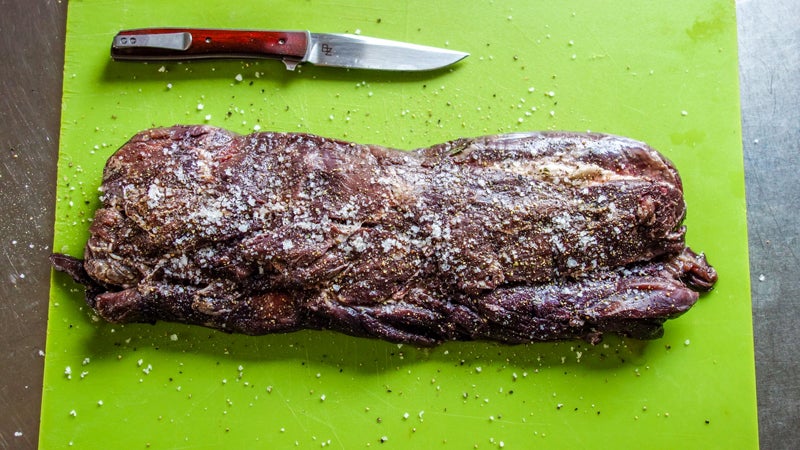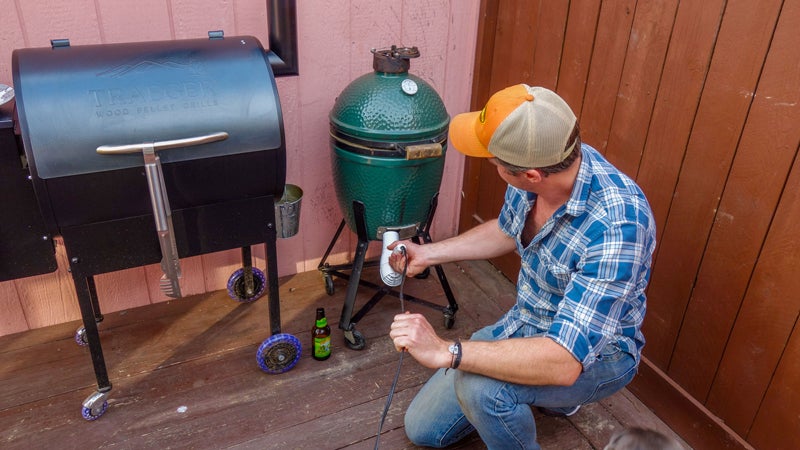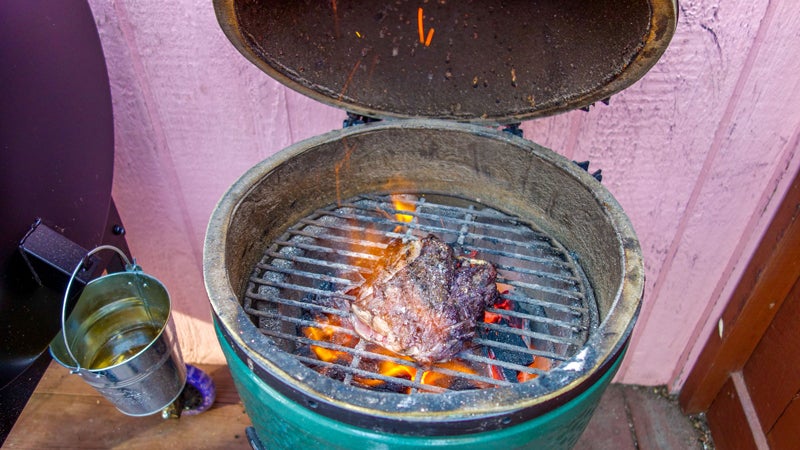Both propane and charcoal briquets pollute the taste of your meat. That’s why serious barbecuers use either pellets made from select hardwoods or natural lump charcoal, containing only hardwood. Those two approaches are epitomized by Traeger and Big Green Egg, respectively. But, is one better than the other? The answer surprised us.
The Traeger is a wood pellet grill. In it, pellets are drawn from a side-mounted hopper into a central burn chamber by an auger, then ignited by a hot metal rod. Those mechanisms run on electricity, so you’ve got to plug it in. It offers precise, digital temperature control integrated with meat thermometers. To operate it, all you have to do is fill the hopper with pellets, turn it on, and dial in whatever temperature you want—anything from “smoke” to 450 degrees Fahrenheit.
In contrast, the Big Green Egg is a strictly analog experience. The Japanese Kamado-style grill is a big, egg-shaped ceramic box that facilitates exact temperature control via adjustable airflow. Its shape and materials both distribute heat evenly and hold in moisture. The Egg is more capable of hitting both extremely low temperatures (150-degree smokes are possible) and extremely high ones than a typical charcoal grill. My regular steak cooking method on it involves 1,200-degree sears. It’s also capable of holding whatever temperature you want for extended periods. Once you’ve started it and stabilized the temperature, it’s easy to set it at 200 degrees and walk away for eight hours while your brisket smokes. It’ll hold that temperature evenly for that much time or longer.
For this test, I wanted to try a side-by-side comparison on the same cut of a difficult-to-perfect meat: venison backstrap. I’ve owned the Egg for two years now, and Traeger sent over this Lil Tex Pro for the test in December. I’ve used both extensively for grilling everything from dove breasts to venison to antelope heart, and even regular ol’ ribeyes, smoking, searing, and roasting them for large dinner parties or just meals for me and Wiley. Once or twice, I’ve even cooked veggies on them. So, while we’ll be comparing both grills’ on that piece of venison, this review will also be drawn from wider long-term experience on both products.
The Meat

I put an arrow through this blacktail one day last fall just before dark, gutted it, then carried the deer off the mountain with a few friends, before butchering it that night with the aid of a 13-year-old girl. I was rusty and screwed up the first six inches of the first five-foot backstrap I pulled out of it. As luck would have it, that also happened to be the piece of meat I pulled out of the freezer the night before the test. So not the prettiest presentation, but still a great tasting hunk of venison utterly free from the gaminess that results from non-immediate kills and tardy meat processing.
For a marinade, I riffed on Traeger’s own recipe, adding some lemon juice and skewing heavy on the wine.
Like other wild game, venison is incredibly lean and, as a result, very sensitive to cooking temperature and time. It takes much more careful attention to temperature than you’re used to from making chicken or steak, and typically lower temperatures for less time. Overcook it by even a few degrees and it’s ruined.
I cut this hunk of backstrap in half, evenly, and set out to achieve a perfect 130-degree medium rare on both grills.
The Cooking Process

For the Traeger, I followed their own recipe exactly. To start, you plug the grill in, open the lid, turn it to smoke, and wait five minutes for the grill to warm up. Then you dial in whatever temperature you want. You don’t have to futz with a lighter or vents or anything like that, there’s just a switch, a dial, and a digital temperature display. For venison, Traeger calls for a 20 minute cook time at 450 degrees. You “sear” the meat for a few minutes on each side, then stick the thermometer probe in it and wait for 130-degree to display.
I put quotes around “sear” because this is a big limitation on this grill. With a maximum achievable temperature of only 450 degrees, you’re not getting the kind of quick, high temperature effect you’d achieve on the Egg or with a cast iron pan on a stove top. For a dinner party the other night, I used that cast iron to put a more significant sear on two antelope shoulders before roasting them in the Traeger for an hour at 300 degrees. Those results on thicker cuts of meat were absolute perfection, but with a thinner slice of meat, I wanted to follow Traeger’s directions exactly for this test.
Because the Traeger is combusting unburnt wood, it produces a significant amount of smoke throughout its cooking cycle. This is the reason why different varieties of wood are available—the smoke plays a big role in the flavor of the meat.
To start the Egg, I first cleared out all the ash in its trap to ensure best-possible results, then loosely stacked large lumps of natural charcoal in its fire pit. As I went, I put six Vaseline-coated cotton balls where they could best ignite the charcoal. I touched those off with a long barbecue lighter, then left the lid open and the bottom intake vent wide until the charcoal was strongly lit. It’s not until that point that you can close the lid and begin manipulating temperature via the adjustable intake and exhaust.
Because airflow is your only tool to adjust temperature on the Egg, forced induction can be a major help in more quickly varying temperature or achieving extremely high temperatures. A huge variety of accessories are available for Big Green Eggs, but most are very expensive. Instead of a purpose-made, clip-on fan, I simply employ a $9 hair dryer for blowing extra air into the grill.
This aids with startup, helping you achieve a complete burn earlier on, but it’s also how I quickly bring the Egg up to very high temperatures for searing. To cook the venison, I used the same method I use for a good ribeye: a quick sear on both sides at 1,200 degrees, then pull the meat off and allow it to decompress while I shut the vents on the Egg and bring it down to 300 degrees. There, I stabilize the temperature and cook the meat for about an additional 10 minutes per side, inserting a meat thermometer and checking its temperature until desired results are achieved.
You can use wood chips to flavor meat on the Egg, but I typically only do that for smoking. You buy those separately, soak them in water overnight, then put them on the coals just before you’re ready to cook, so it takes some additional planning.
Cooking Times

It takes the Traeger about 20 minutes to come up to 450 degrees and the venison needed about 20 minutes of cooking time. So figure 40 minutes minimum—a few more if you’re not standing right there, turning the dial up to 450 as soon as the pellets start smoking.
Giving the Egg a little TLC before starting it (cleaning ash, carefully stacking charcoal) takes a minute or two, but is a big help in helping it rapidly light and achieve high temperatures. Figure 10 minutes from putting the lighter down to reaching 1,200 degrees, if you’re using that hair dryer or another, less redneck method of forcing air in. From there, it’s 30 seconds per side for searing, then a20-minutee wait for temps to come down with vents closed. Then 10 minutes a side. Total: also about 45 minutes.
You could use a similar method to Traeger’s with the Egg and simply bring it to, and keep it at, 450 degrees. That’d knock off both that 20 minute wait time and a few minutes from the startup. The ability to quickly get going and get up to temperature is a big advantage the Egg can have, depending on how you use it.
Results

With a stronger sear and meat that appears to be juicier, I initially thought the Egg had taken a solid victory. But, largely due to my own incompetent butchering, the Traeger ended up cooking an end of the backstrap that was, well, messy. So, it doesn’t look as impressive but it actually tasted better. While both grills produced meat that was moist and well cooked, it surprises me to say that the Traeger produced notably more tender results. Both pieces of meat were good, but the Traeger’s was tastier.
Price, Ease of Use, and Other Considerations

The grills featured here are not equivalent in size. This doesn’t impact their ability to make great meat, but it does affect the price. The pictured Big Green Egg is the $559 small and has only 133 square inches of cooking real estate. Traeger’s $800 Texas Elite 34 has a 22-by-19-inch main grilling surface (let’s discount the second, smaller top rack for now) for 418 square inches to cook on. That makes it loosely equivalent, in terms of the amount of meat you can get on there, to the $1,200 Big Green Egg XL.
While the Egg can use any natural lump charcoal, Traeger strongly recommends that you stick to its own brand pellets. Neither fuel source is quite as universally available as propane canisters or charcoal briquets, but neither is terribly hard to find, either. Both are available at my local hardware store and you can buy both from Amazon Prime, with free delivery. I haven’t noticed more cost in fuel for either grill—you can be pretty economical with both if you’re good about only lighting them when you’re ready to cook, then shutting them down immediately when you’re finished.
You don’t need to clean ash out of the Traeger with the same regularity as the Big Green Egg, but it does still collect it. You’ll never need to clean any grease out of the Egg as residual heat burns it off, but you will need to regularly clean grease from the plate under the grill of the Traeger. Both are made from corrosion-resistant materials and show no signs of wear or tear from living outside for extended periods, but both also benefit from being covered, if only to keep them clean.
You’ll need an outdoor outlet or long, three-prong extension cord for the Traeger. With the egg, you only need to be able to reach it with that hair dryer.
The Traeger is ready to smoke, grill, or roast out of the box. To smoke on the Egg, you’ll need the $110+ plate setter accessory, a metal dog bowl to hold water under the grill, and a separate bag of wood chips.
If you’re using the Egg at high temperatures, you’ll go through lid gaskets with disappointing regularity. I fitted a $33 aftermarket, high performance gasket to mine, but after three months, it’s already shot.
I haven’t burned myself once on the Traeger. Using the Egg, I’d advise a hefty set of leather work gloves. The height of flames and amount of sparks I get to come out of the top of the Egg with that hair dryer (or leaf blower!) routinely reach dangerous levels. I wear my Egg scars with pride.
Which Grill Is Right for You?

If you want to reliably grill meat to perfection with little effort, then you’ll want the Traeger. It produces consistent, reliable, great results, every single time. While it uses wood as a fuel source, it provides digital control, simplifying the grilling process and making it positively foolproof.
You could tackle a smoked brisket—a notoriously difficult thing to barbecue, and an expensive hunk of meat—for the first time on a Traeger with near a 100 percent expectation of success. On the Egg, I got lucky and produced a perfect brisket on my first try, created a second one that wasn’t quite as good, and totally ruined my third. But the challenge is a big part of the Big Green Egg’s appeal.
A Big Green Egg requires a significant learning curve just to cook simple things, but encourages experimentation and artistic expression with your cooking. While the tenderness of the venison it cooked may have fallen behind the Traeger, this time, that’s simply encouraged me to develop and try new grilling processes until I nail it. That might cost me a few pieces of meat, but that benefits Wiley. As an analog experience, the Egg is fun to use, will often burn you, and offers unlimited cooking possibilities. If you treat cooking as an art form, and enjoy playing with fire, you’ll want the Big Green Egg.

